- By Dan Veaner
- News
 Print
Print
Ludlowville residents came to Lansing Town Hall Wednesday to learn what is going to be done about storm water and flooding that has caused substantial damage to the hamlet over many years. Tompkins County Senior Planner Scott Doyle hosted the meeting th get input from the effected residents, and to outline a $480,000 project that will improve drainage and help to avoid future damage.
"When I was first briefed on the Ludlowville project there were two things of note," Doyle said. "One was the complexities of the flooding issues here. Secondly it struck me how important this project is in your community. Part of that is evidenced by all of you coming together to work on this project."
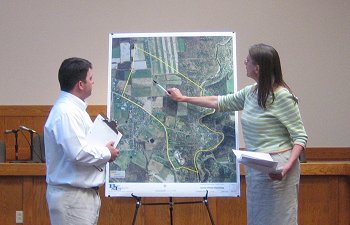
Resident Maria terrell shows how water floods from Lansingville Road across her
property, and then down into the center of Ludlowville as Charles White looks on
(The yellow outline shows the scope of the project)
Doyle has been working with residents to collect historical information and to learn precisely where flooding occurs and where the water is coming from. He sent a survey to residents asking for their input, and reiterated that he hopes more residents will respond. He says that half of the $480,000 is provided from the DEC's Water Quality Improvement Project funding, while $240,000 is matched locally mainly through in-kind use of construction equipment and labor.
"The project cost covers three phases - the project feasibility study, design implementation and project construction," he explains. "Any added funding that comes through FEMA's Pre-Disaster Funding will be used to further support construction of mitigation measures. The exact amount of added funding has yet to be finalized by FEMA."
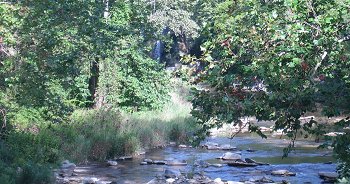
Water floods Ludlowville on its way to Salmon Creek
Doyle introduced the project team of Senior Project Environmental Scientist David Hanney, Senior Project Engineer Charles White, and Vice President Scott Nostrand, all of Barton & Loguidice, a Syracuse-based engineering and planning firm. Ludlowville is in the valley that follows Salmon Creek as it divides the town, at the bottom of a steep hill that goes downhill from the west. Hanney explained that while the focus was originally on a culvert on Ludlowville Road that is supposed to feed storm water into Salmon Creek, the project has widened to look at sources of the water to the north.
Resident Maria Terrel agreed that much of the runoff comes from Lansingville Road near Bensview Farm. "There are two culverts on either side of Lansingville Road," she explained. "It is steep as it heads to the north. Both sides of the road drainage runoff are connected with a pipe that goes under Lansingville road and the water is diverted to Sarah Kane's property line and mine. A tremendous volume of water comes down both sides of the road, then makes a right angle turn. This becomes a very deep gorge, probably about 20 feet deep."
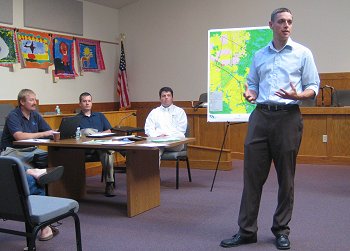
Scott Doyle (standing) introduces the project team of (Left to right)
Scott Nostrand, David Hanny, and Charles White
Resident James Mason was concerned with large volumes of runoff that have repeatedly occurred, causing substantial damage to his property as well as neighbors'. He noted that Kane and Ethel Cratsby had lived through the 1935 flood. "I've seen water on Lansingville Road where the water was two to two and a half inched deep. It was coming off the hillside and sheeting straight across those drainage ditches and then coming into their properties. The '35 flood eroded Ludlowville Road such that Sarah could get in the ditch and it would be over her head."
"There are some long standing abuses where water has been diverted," Terrel said. "This is not a natural waterway. This is a man made property line which has been eroded to a very deep level by this water that's been illegally diverted."
"In this discussion we are having with agencies that are responsible for this problem," Mason said, "I believe that they should be held accountable for damages. We are bearing that cost, and they are passing on the responsibility of discharge onto property owners that don't have the means to force the true issue."
Cratsby remembered that the water was diverted in the '30s, when she was ten years old. A former Lansing Highway Superintendent evidently diverted the water in the 1930s, and that has exacerbated the problem for close to 80 years.
"It's illegal to divert water onto somebody;'s property, right?" asked Kane. "But it was done. We have lost a lot of land."
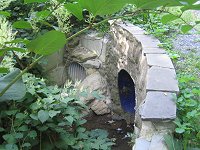 "After it gets past my property, which had a six foot gully that is now 14 feet deep, I lose two two three feet on a yearly basis," said resident Ken Gagnon. "A deer carcass clogged a culvert, and all of a sudden we got major flooding down the road and through the back properties."
"After it gets past my property, which had a six foot gully that is now 14 feet deep, I lose two two three feet on a yearly basis," said resident Ken Gagnon. "A deer carcass clogged a culvert, and all of a sudden we got major flooding down the road and through the back properties."
He said that other culverts, such as one near the old school house part way up the hill, clog or overflow and become part of the problem.
In the early part of the last century Ludlowville was a thriving community with stores, a post office and barber shop, an ice cream shop, its own school, a saw mill, fire hall, and two churches. Wharton Studios famously filmed silent movies there. Today it is largely a residential neighborhood that clings to the gorge around Salmon Creek. It boasts a town park along the edge of the gorge, and several spots where anglers can stop to fish. The repeated flooding has been an ongoing problem, and an expensive one.
"It's really hard to have your home flooded several times, ongoing," Mason said. "People are losing a lot of property."
Gagnon noted that one neighbor has paid thousands of dollars to try to repair damage from washouts. In fact a 2006 FEMA grant totaled $315,000 to cover Ludlowville flooding losses between 1991 and 2005 that included soil and tree loss, flooded homes, and removing rock deposits left by floods.
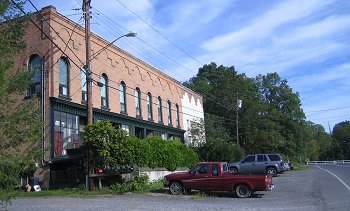
While the old 'Brick Block' is the most identifyable Ludlowville
landmark, the hamlet continues down the hill along Salmon Creek
The project team was optimistic that solutions could be under construction as early as next Spring. "Once an alternative is selected we will go into the final design stage," White said. "It is anticipated that this would be designed as a number of smaller projects that could be completed in concert with the Town and County. We're looking to run the study through the Fall and by Spring we hope to have alternatives on the table for consideration. Construction in some areas could be as early as next year."
"There is a lot of documentation, and that's helped a lot in terms of opening the door to funding from the State. It has also caught the attention of the federal level. Congressman Arcuri is trying to finalize more funding from FEMA to help support this as well. And there is local support from the Town and County."
He promised to stay in touch with residents, and to hold future public meetings to talk about the results engineers find, continue to get input from residents, and to suggest measures for mitigating the problems.
----
v4i33
"When I was first briefed on the Ludlowville project there were two things of note," Doyle said. "One was the complexities of the flooding issues here. Secondly it struck me how important this project is in your community. Part of that is evidenced by all of you coming together to work on this project."

Resident Maria terrell shows how water floods from Lansingville Road across her
property, and then down into the center of Ludlowville as Charles White looks on
(The yellow outline shows the scope of the project)
Doyle has been working with residents to collect historical information and to learn precisely where flooding occurs and where the water is coming from. He sent a survey to residents asking for their input, and reiterated that he hopes more residents will respond. He says that half of the $480,000 is provided from the DEC's Water Quality Improvement Project funding, while $240,000 is matched locally mainly through in-kind use of construction equipment and labor.
"The project cost covers three phases - the project feasibility study, design implementation and project construction," he explains. "Any added funding that comes through FEMA's Pre-Disaster Funding will be used to further support construction of mitigation measures. The exact amount of added funding has yet to be finalized by FEMA."

Water floods Ludlowville on its way to Salmon Creek
Doyle introduced the project team of Senior Project Environmental Scientist David Hanney, Senior Project Engineer Charles White, and Vice President Scott Nostrand, all of Barton & Loguidice, a Syracuse-based engineering and planning firm. Ludlowville is in the valley that follows Salmon Creek as it divides the town, at the bottom of a steep hill that goes downhill from the west. Hanney explained that while the focus was originally on a culvert on Ludlowville Road that is supposed to feed storm water into Salmon Creek, the project has widened to look at sources of the water to the north.
Resident Maria Terrel agreed that much of the runoff comes from Lansingville Road near Bensview Farm. "There are two culverts on either side of Lansingville Road," she explained. "It is steep as it heads to the north. Both sides of the road drainage runoff are connected with a pipe that goes under Lansingville road and the water is diverted to Sarah Kane's property line and mine. A tremendous volume of water comes down both sides of the road, then makes a right angle turn. This becomes a very deep gorge, probably about 20 feet deep."

Scott Doyle (standing) introduces the project team of (Left to right)
Scott Nostrand, David Hanny, and Charles White
Resident James Mason was concerned with large volumes of runoff that have repeatedly occurred, causing substantial damage to his property as well as neighbors'. He noted that Kane and Ethel Cratsby had lived through the 1935 flood. "I've seen water on Lansingville Road where the water was two to two and a half inched deep. It was coming off the hillside and sheeting straight across those drainage ditches and then coming into their properties. The '35 flood eroded Ludlowville Road such that Sarah could get in the ditch and it would be over her head."
"There are some long standing abuses where water has been diverted," Terrel said. "This is not a natural waterway. This is a man made property line which has been eroded to a very deep level by this water that's been illegally diverted."
"In this discussion we are having with agencies that are responsible for this problem," Mason said, "I believe that they should be held accountable for damages. We are bearing that cost, and they are passing on the responsibility of discharge onto property owners that don't have the means to force the true issue."
Cratsby remembered that the water was diverted in the '30s, when she was ten years old. A former Lansing Highway Superintendent evidently diverted the water in the 1930s, and that has exacerbated the problem for close to 80 years.
"It's illegal to divert water onto somebody;'s property, right?" asked Kane. "But it was done. We have lost a lot of land."

This culvert near the old Ludlowville school overflows in major storms
He said that other culverts, such as one near the old school house part way up the hill, clog or overflow and become part of the problem.
In the early part of the last century Ludlowville was a thriving community with stores, a post office and barber shop, an ice cream shop, its own school, a saw mill, fire hall, and two churches. Wharton Studios famously filmed silent movies there. Today it is largely a residential neighborhood that clings to the gorge around Salmon Creek. It boasts a town park along the edge of the gorge, and several spots where anglers can stop to fish. The repeated flooding has been an ongoing problem, and an expensive one.
"It's really hard to have your home flooded several times, ongoing," Mason said. "People are losing a lot of property."
Gagnon noted that one neighbor has paid thousands of dollars to try to repair damage from washouts. In fact a 2006 FEMA grant totaled $315,000 to cover Ludlowville flooding losses between 1991 and 2005 that included soil and tree loss, flooded homes, and removing rock deposits left by floods.

While the old 'Brick Block' is the most identifyable Ludlowville
landmark, the hamlet continues down the hill along Salmon Creek
The project team was optimistic that solutions could be under construction as early as next Spring. "Once an alternative is selected we will go into the final design stage," White said. "It is anticipated that this would be designed as a number of smaller projects that could be completed in concert with the Town and County. We're looking to run the study through the Fall and by Spring we hope to have alternatives on the table for consideration. Construction in some areas could be as early as next year."
"There is a lot of documentation, and that's helped a lot in terms of opening the door to funding from the State. It has also caught the attention of the federal level. Congressman Arcuri is trying to finalize more funding from FEMA to help support this as well. And there is local support from the Town and County."
He promised to stay in touch with residents, and to hold future public meetings to talk about the results engineers find, continue to get input from residents, and to suggest measures for mitigating the problems.
----
v4i33



